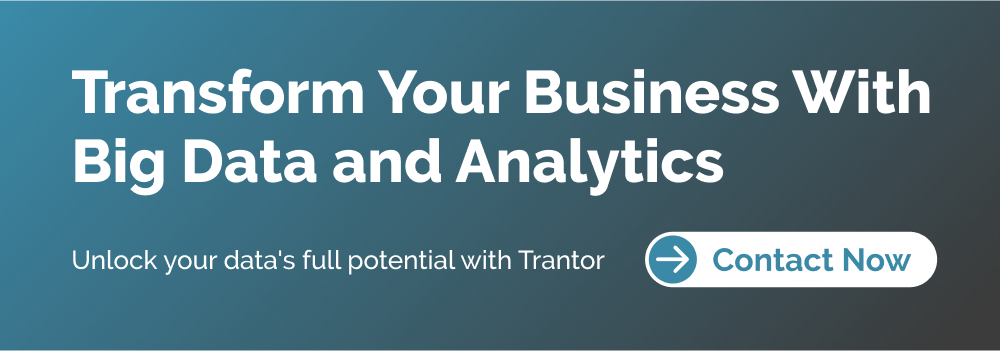Big Data, zBlog
Top Big Data Trends for 2023 and Beyond
atif | Updated: April 25, 2023

The global big data market revenue will hit 103 billion US dollars by 2027. The current BI and analytics software market is valued at 16 billion USD globally.
Besides the stats that speak a thousand words, big data, associated with AI, ML, and other technologies, is fueling the Fourth Industrial Revolution. Big data analytics is one of the most influential big data trends, reshaping numerous business processes and operations worldwide.
Rapidly expanding IoT networks, Data as a product, quantum computing, and data use for hyper-personalization are emerging big data trends in the segment.
Big data trends are driving the usage of AI, ML, and other innovative processing technologies to analyze, process, and parse massive datasets in multiple sectors, such as Healthcare, e-commerce, Government Data, Public Infrastructure, Banking & FinTech, Security, Manufacturing, Natural Resources Management & Harnessing, etc.
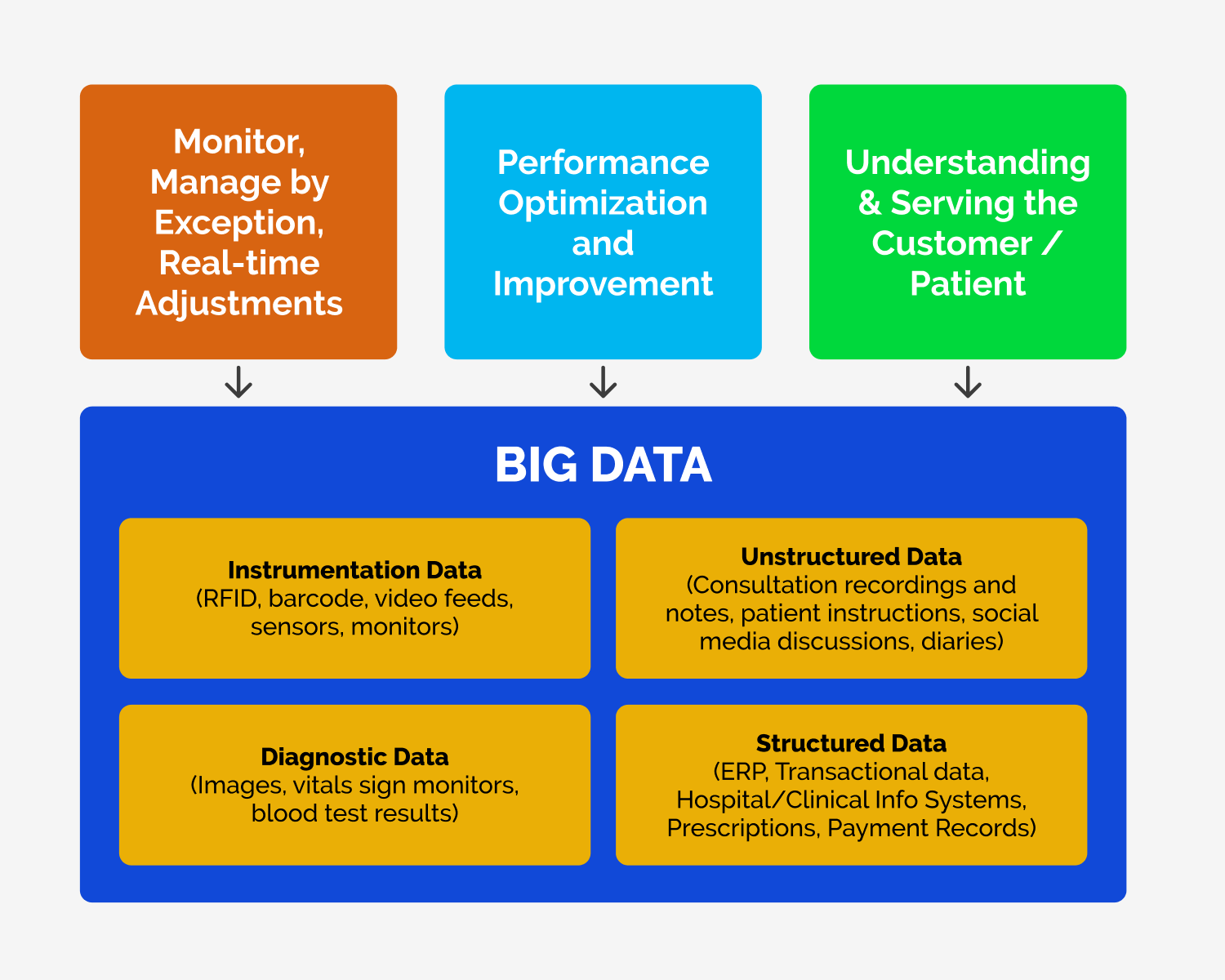
The latest studies reveal that in just two years, Big Data has spurred a change in the business perspective across the entire globe.
It forced business organizations to rethink their:
- Business strategies
- Data storage and management
- Data processing
- conceptual data-related functions
With more than 2.5 quintillion bytes of data being generated daily. it is more than safe to assume that Big Data is gearing up to change the way we think!
Here, we are sharing the top 10 Big Data trends in 2023 that will be the significant change drivers.
Top 10 Big Data Trends for 2023: Revolutionizing the Core of Modern Business Landscape
1. AI Will Continue to Improve, but Humans Will Remain Crucial
The rise of artificial intelligence is empowering businesses and industries across the globe and empowering people with unprecedented capabilities. While the general perception is of “massive overlays and mass firings“, the experts say humans will still be “crucial“.
A recent Forbes feature outlined how robots will not eliminate the human task force. Further, an MIT study suggests that AI will continue to fuel massive innovation across the globe and will create many sectors for growth and employment.
Hence, it will improve the human race and how we live, work, and grow.
However, to keep the social and economic divide contained, the stakeholders have to have some common goals to adhere to, such as:
- Creating policies and regulations to ensure that AI is directed at the “common good” of humanity
- Improve human collaboration across global stakeholder groups
- Prioritizing people over the entire “race with the robots” sentiment
Also, humans have a distinct way of learning, perceiving, and responding to things, incidents, and people around them. Hence, while the future might have brilliant AI-powered customer staff, the overall management of operations will still require humans.
2. Business Intelligence in Every Walk of Life
Business intelligence, or BI, is already changing multiple sectors: marketing, consumer services, customer experiences, and the entire eCommerce segment. The value of the global BI and analytics software market is expected to be 17.6 bn USD by 2024.
The flawless and efficient BI software data processing capabilities help companies worldwide accomplish their corporate and data goals without hassle.
Apart from the current sectors employing BI, such as supply chain management, resource management, and customer interaction management, it is also expected to revolutionize the technology and manufacturing sectors.
BI software draws its strength from:
- Data preparation
- Analytical querying of prepared data
- Distribution of KPIs
- Use the information to drive business decisions
Take a look at some of the future applications of BI:
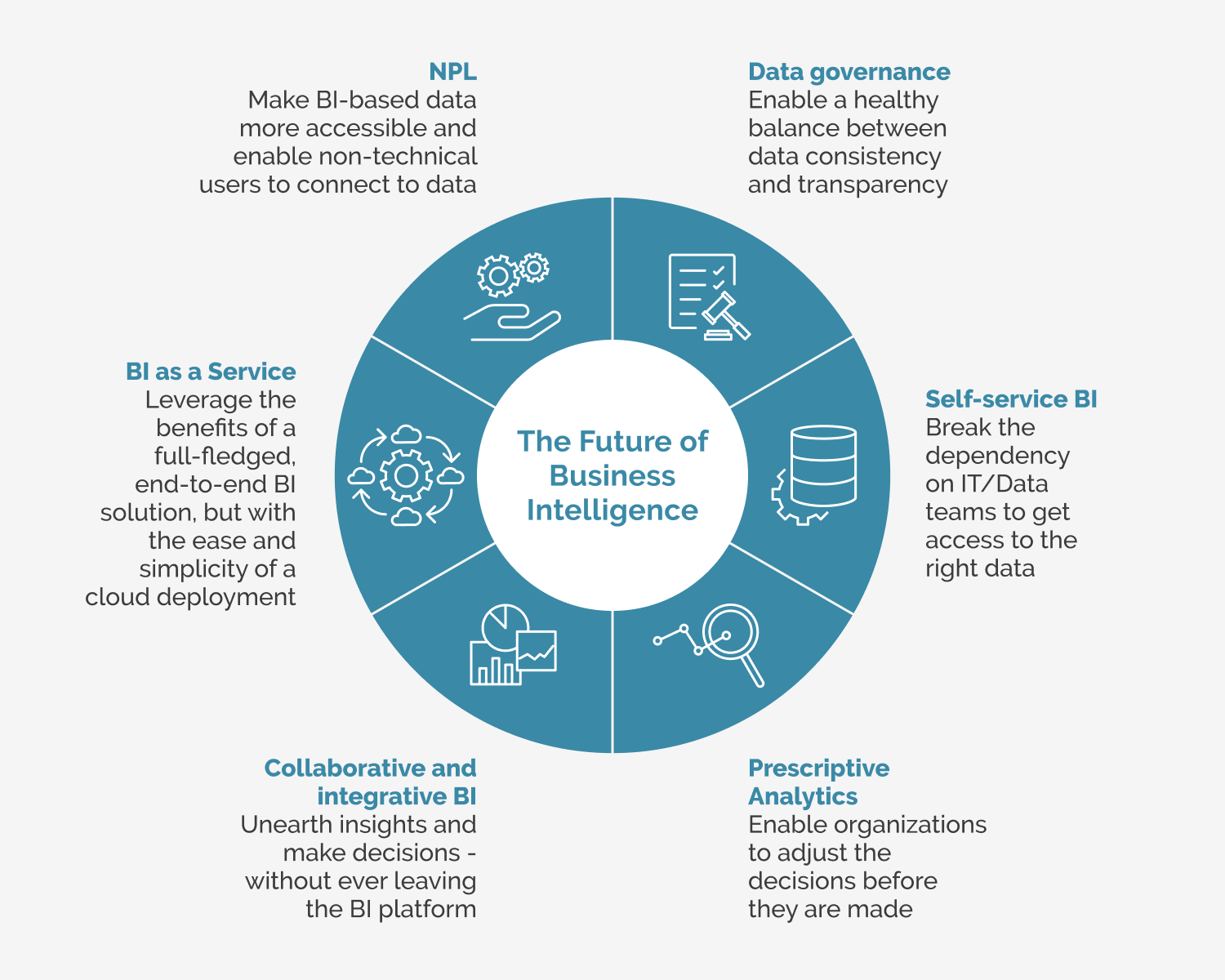
3. Predictive Analytics
Big data has been empowering business organizations and data analytics stakeholders with its fundamental approach for a while now. It helps them to gain a competitive edge and accomplish their goals, such as better services, more sales, more customers, happier customers, and so on.
Business organizations use multiple tools to achieve these goals, and predictive analysis is a common feature of these tools.
Predictive methods use historical events and modern data to uncover hidden big data trends and present actionable insights, such as:
- With the current business approach, how many customers will leave your brand in the next five years?
- How many products can you sell in the coming quarter, and the potential risks involved?
Overall, predictive analysis offers you a realistic and data-driven future prediction. With advancements in Big Data, Artificial Intelligence, Machine Learning, and other technologies, predictive analytics is all set to gain more power and offer more crucial insights.
So, you can predict customer response, churn, and purchase behavior and optimize your brand offerings, services, and business agendas accordingly.
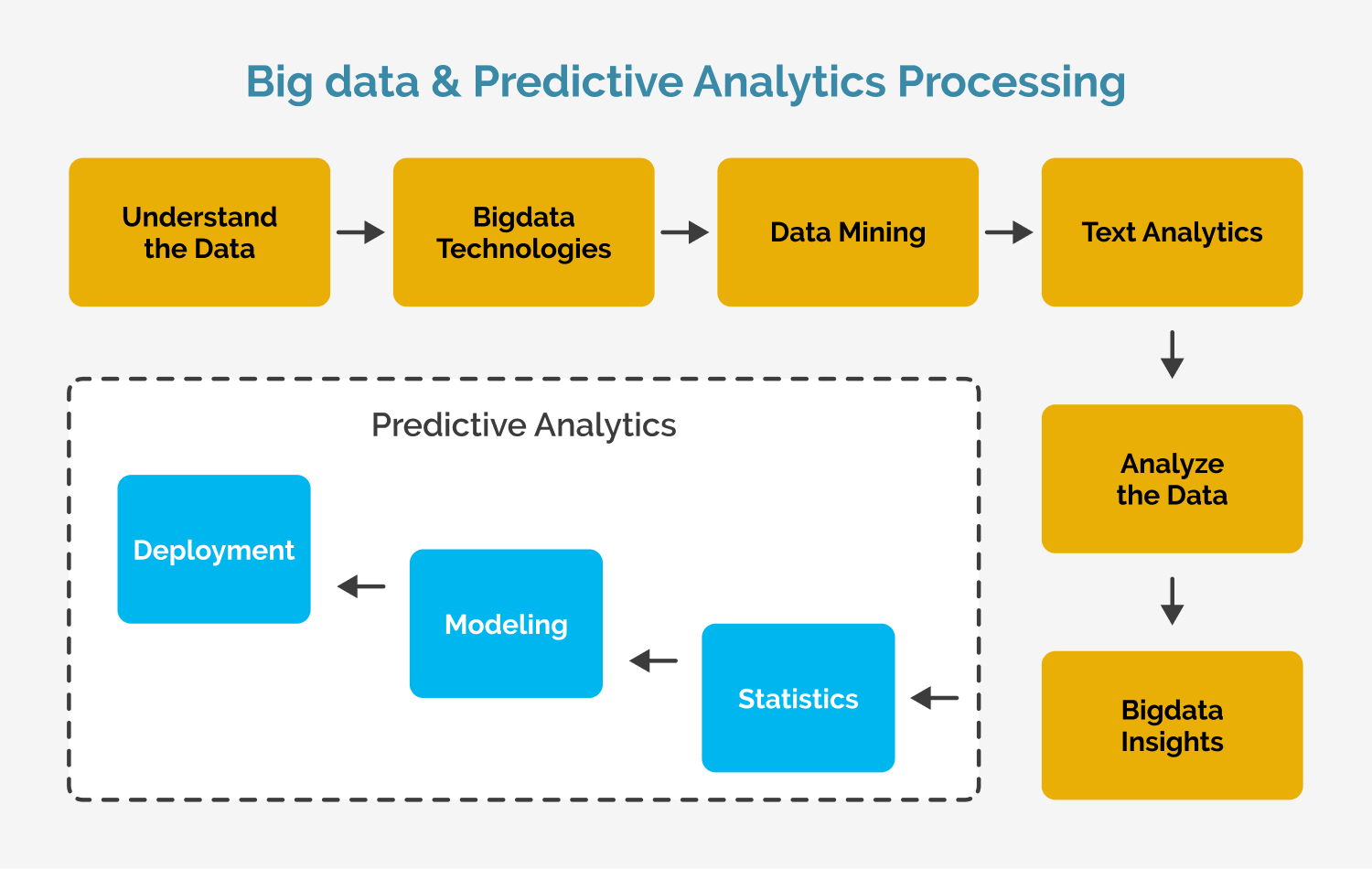
The visual shows how predictive analytics can identify the meaningful patterns of big data and generate future predictions to identify the value proposition of various options.
4. Cloud-Native Analytics Will Become Necessary
A recent study by IDC predicts that the global cloud-native analytics market will reach $12.8 billion by 2025, growing at a CAGR of 25.1% from 2021 to 2025. This growth is driven by the increasing adoption of cloud computing by businesses of all sizes and the growing demand for real-time analytics and insights.
Cloud-native analytics is a type of analytics that is built and deployed on cloud computing platforms. Cloud-native analytics offers many benefits over traditional on-premises analytics, including:
- Scalability: Cloud-native analytics can be scaled up or down to meet the changing needs of a business. This is important for businesses that need to process large amounts of data or that experience spikes in demand.
- Elasticity: Cloud-native analytics can be provisioned and de-provisioned as needed, which helps businesses save money.
- Pay-as-you-go pricing: Cloud-native analytics is typically priced on a pay-as-you-go basis, meaning businesses only pay for the resources they use. This can help businesses save money on their analytics costs.
- Real-time insights: Cloud-native analytics can process and analyze data in real time, which can help businesses make faster and better decisions.
The sectors that are most likely to benefit from cloud-native analytics include:
- Government: Cloud-native analytics can be used to improve government efficiency and transparency. For example, it can be used to analyze data from social media and other sources to track public opinion or to identify fraud.
- Healthcare: Cloud-native analytics can be used to improve patient care and outcomes. For example, it can be used to analyze medical data to identify patients at risk for certain diseases or track treatments’ effectiveness.
- Retail: Cloud-native analytics can be used to improve customer experience and engagement. For example, it can analyze customer data to identify trends and personalize marketing campaigns.
- Manufacturing: Cloud-native analytics can be used to improve operational efficiency and productivity. For example, it can be used to analyze production data to identify bottlenecks or to optimize supply chains.
5. Digital Transformation
Digital transformation stems from the ability of an organization to combine both automation and digitization.
As the global business landscape becomes more competitive, sophisticated, and highly data-centric, Big Data emerges as one of the key drivers of digital transformation. Businesses across the globe utilize vast chunks of unstructured data to discover the hidden patterns concerning their business models, and Big Data becomes all the more important.
Take a look at some ways Big Data triggers digital transformation:
- Big data analytics offer granular insights about specific customer clusters
- Big data analytics for delivering highly tailored services to specific market segments
- Implement future data predictions to make businesses more aligned with customer expectations
- Utilizing massive data stores to drive growth and streamline business processes
6. Climate Change Research
Climate change research comes under the term “X Analytics” coined by Gartner. “X” is a data variable for a wide range of structured and unstructured content, such as video, text, and audio analytics.
Leaders in the data analytics segment utilize X analytics to solve the most demanding challenges to humanity, such as disease prevention, wildlife protection, and climate change.
Big Data, in unison with other technologies, such as artificial intelligence, can comb through millions of research papers, news sources, clinical trials, and academic content pages to help climate researchers. The researchers can find new ways to contain the massive climate change, create containment plans for severe outcomes in red zones, and identify the most vulnerable population pools via graph analytics.
Take a look at the following visual that shows various ways big data can benefit climate change researchers:
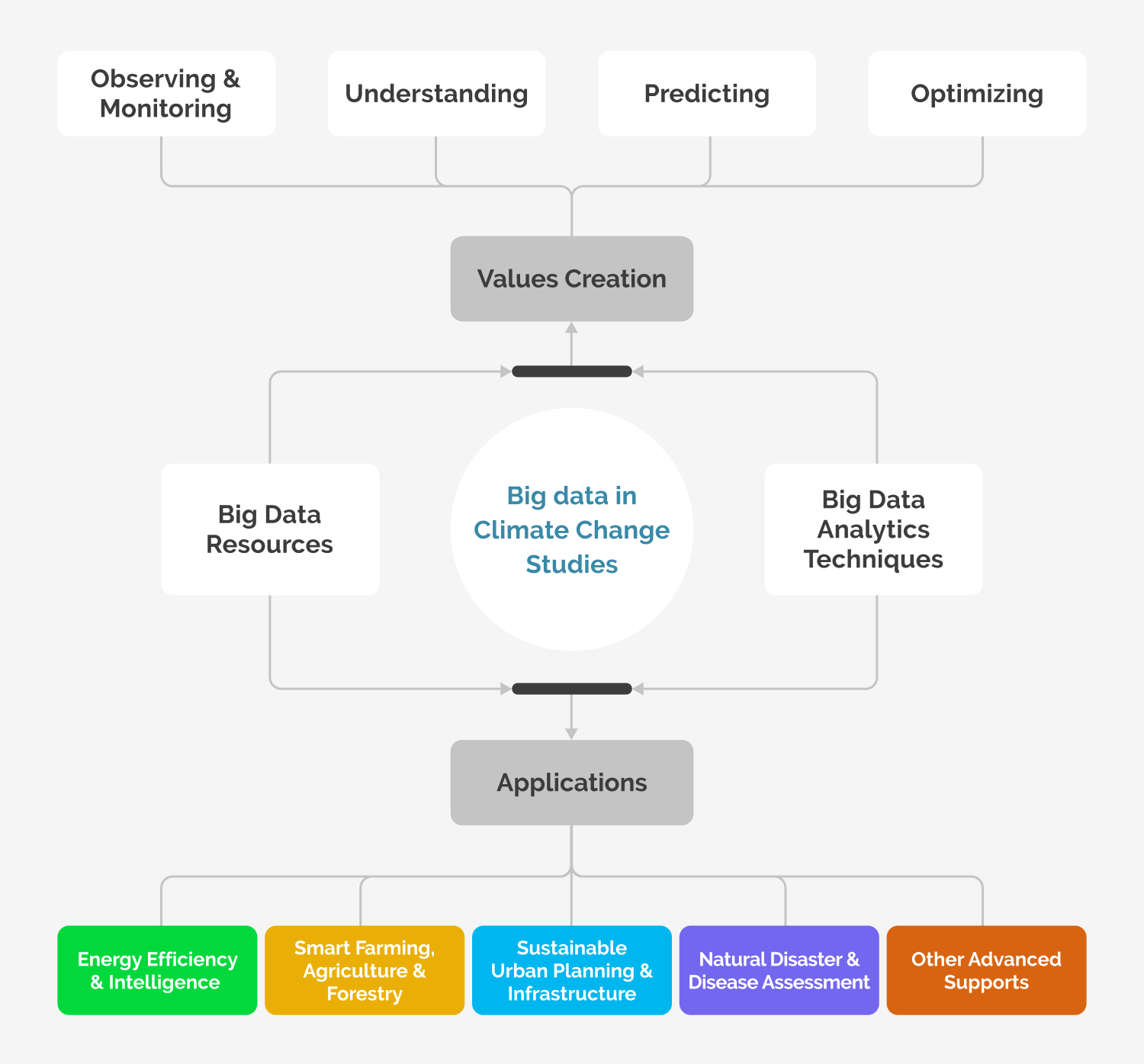
Big Data in Climate Change Studies
Big Data analytics will also empower climate researchers to predict and plan for natural disasters and other crises with predictive models.
7. Medical Cures and Pandemic Control
In the pandemic-struck world, big data analytics and artificial intelligence assumed an extremely reliable stance in procuring the most reliable information. Besides helping research and develop novel treatment procedures, Big Data offered possible opportunities and sources of the correct information, such as patient records, COVID tally, patient-reported travel, etc.
Medical experts use the term “precision medicine“, where medical experts can design an exact treatment procedure via big data analytics.
When it comes to developing the best treatment procedures, there are two ways:
- Classical Methodology: Stems from a priori hypothesis and no reliable insights from historical data
- Big Data Analytics: Hypothesis generation from experimental and historical data
Precision medicine is a synergistic result of the classical methodology and Big Data, as shown in the image below:
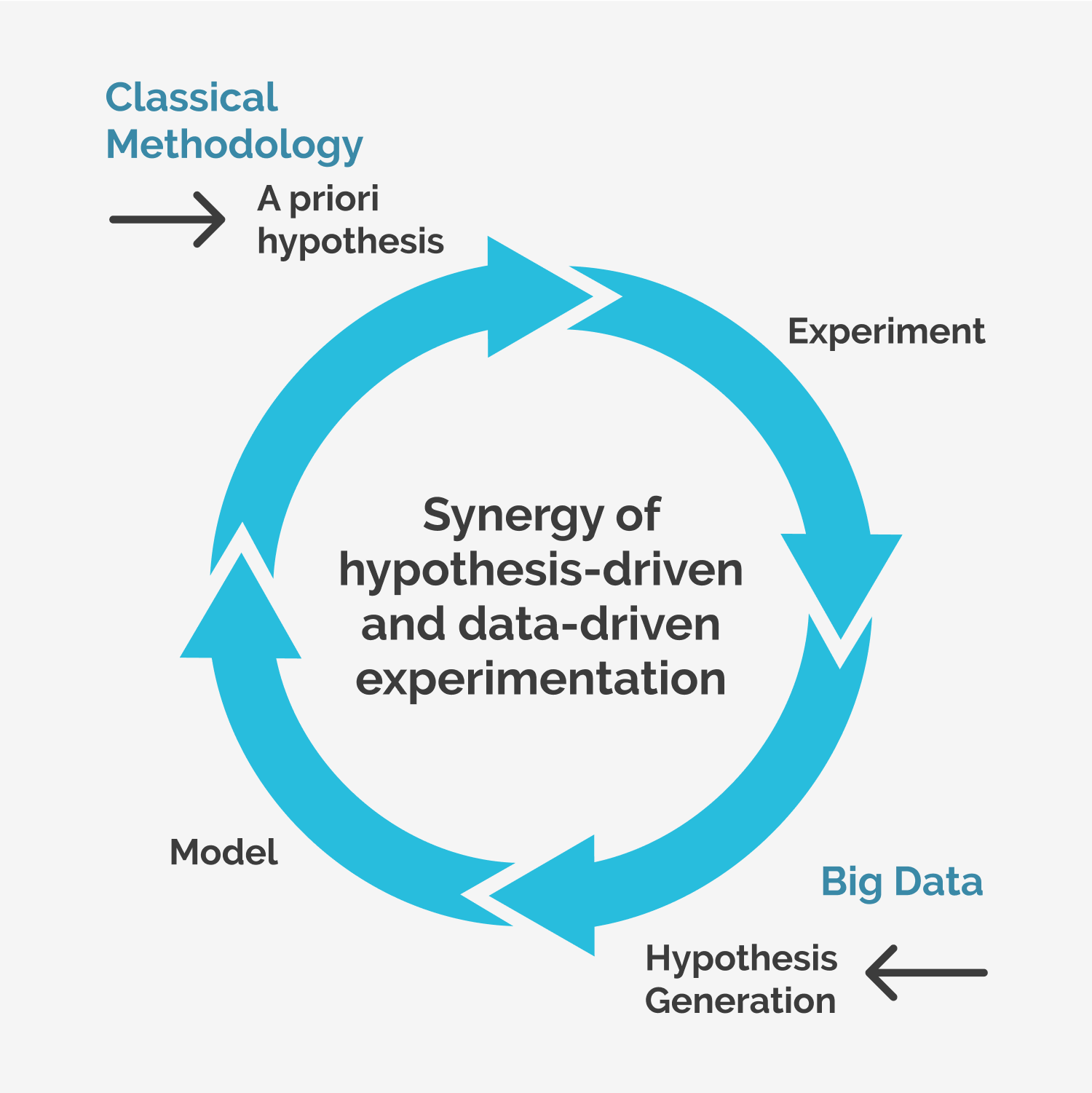
Synergy of Hypothesis-driven and Data-driven Experimentation
Research reveals that Big Data greatly enhanced the abilities of medical researchers to understand the dysfunctional parts of Biology. Further, the medical experts are all set to use Big Data to deliver pragmatic value to clinical practitioners.
8. Fantastic Business Capabilities via Big Data Fabric
Big Data Fabric is an emerging platform concept that can accelerate and refine business insights.
Hence, the business organizations will have a set of data services to deliver capabilities across all the business verticals and a choice of business endpoints in a consistent manner. Further, the platform will standardize data management practices and practicalities across hybrid multi-cloud environments.
Offering unparalleled analytical services, the big data fabric will empower business networks with enhanced security across cloud networks, on-premise systems, and edge devices.
A simple visual representation of big data fabric is shown below, with various components and functions:
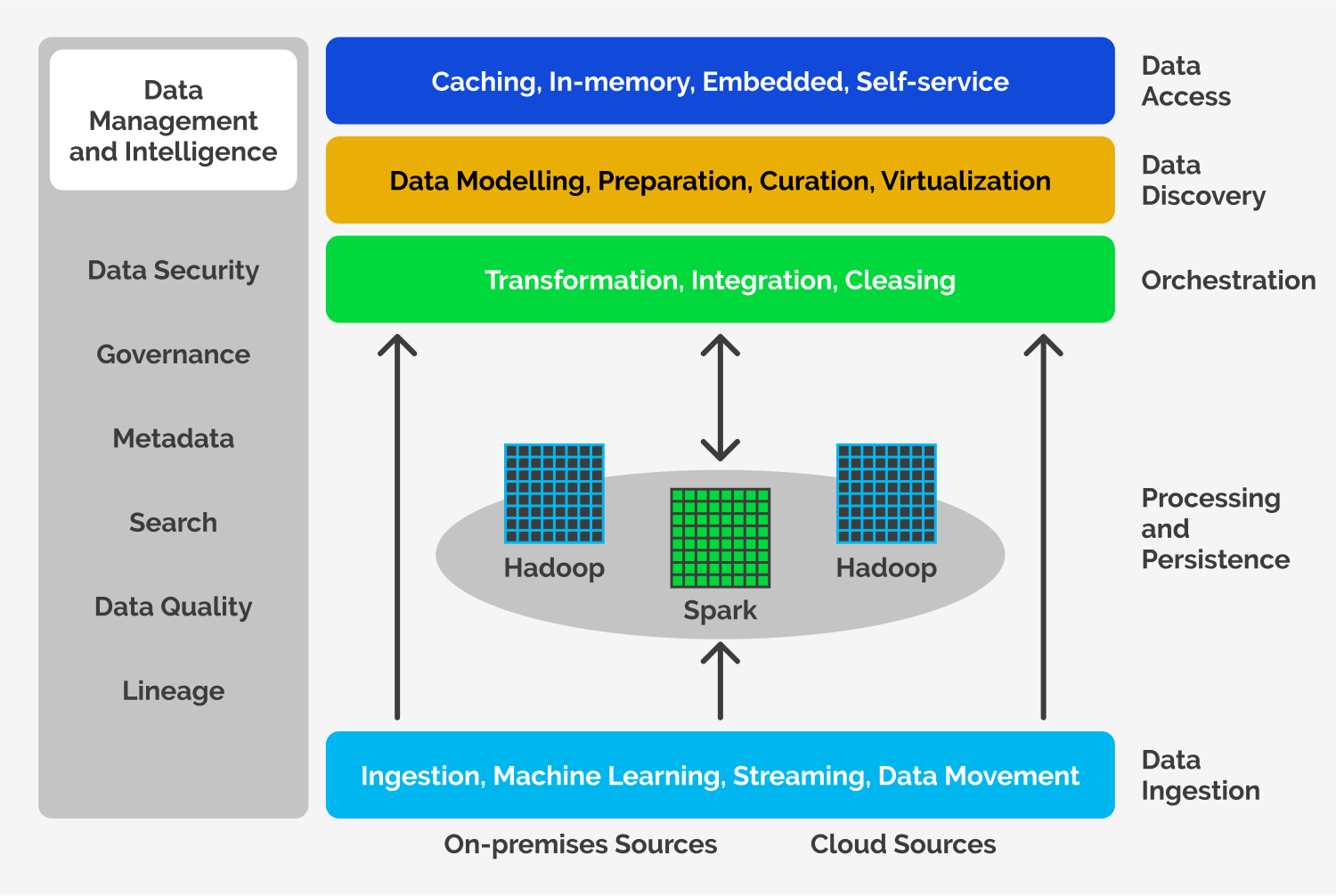
6 Layers of Big Data Fabric Architecture
9. Augmented Data Management
Deloitte and Gartner cite Augmented Data Management as the latest technology trend and suggest that coupling it with AI and ML can unlock various benefits for data management.
ADM, or Augmented Data Management, is an application that enhances the ability to automate data management tasks. Hence, ADM will be a worth-betting trendsetter in the big data landscape 2023.
ADM empowers organizations by making data management more streamlined and straightforward and facilitating automation. Coupling ADM with AI will reduce the automation tasks’ time, effort, and complexity. Further, you can leverage the current data management platforms for experiential learning with Augmented Data Management.
According to the industry experts, the areas where ADM has the most potential are:
- Metadata Management
- Data Quality
- Master Data Management
10. Data-as-a-Service (DaaS)
Data-as-a-service (DaaS) is a cloud-based data management solution that provides businesses access to data storage, processing, and analytics services. DaaS eliminates the need for businesses to invest in and maintain their data infrastructure, saving them time and money.
The global DaaS market is expected to grow from $10.7 billion in 2023 to $20.4 billion by 2028 at a CAGR of 10.5%. This growth is driven by the increasing adoption of cloud computing by businesses of all sizes and the growing demand for big data analytics. DaaS offers many benefits to businesses, including:
- Scalability: DaaS can be scaled up or down to meet the changing needs of a business. This is important for businesses that need to process large amounts of data or that experience spikes in demand.
- Cost-effectiveness: DaaS can be more cost-effective than traditional on-premises data management solutions. Businesses do not need to invest in and maintain their data infrastructure.
- Ease of use: DaaS is typically easy to use and manage. This is because the services are hosted in the cloud and managed by a third-party provider.
- Security: DaaS providers typically offer high security for their data. This is important for businesses that need to protect their sensitive data.
Some of the compelling benefits of DaaS include:
- Simplified data access: DaaS makes it easy for businesses to access their data from any device and anywhere. This can help businesses improve their decision-making and productivity.
- Cost-effective data use and sourcing: DaaS can help businesses save money on data storage and processing costs. This is because businesses only pay for the data and services they use.
- Easy update and monitoring: DaaS providers typically handle the data infrastructure updates and monitoring. This frees up businesses to focus on their core activities.
Big Data Is the Answer: Whatever the Question Is!
With such promising big data trends and many more upcoming ones, big data is undoubtedly all set to revolutionize multiple business sectors, processes, and public infrastructure in general.
However, with more outstanding capabilities and functionalities comes the load of developing better and more reliable security postures and cost-efficiency models. While the world is still gearing up to embrace the set of new duties that are taxing enough, the hybrid data analytics and computing landscape is teeming with disruptions.
And Big Data is the answer, irrespective of the question we have.
Unlock Deeper Business Insights with Trantor’s Data Analytics Services
Harness the power of data with Trantor. Our data analytics experts can empower your business through advanced analytics capabilities, ensuring you get the most value from your data.
As a premier data analytics consulting firm, Trantor goes beyond just tools and platforms. We have become a trusted partner invested in your long-term success. Our customized services range from getting your analytics initiative off the ground to serving as your dedicated analytics team.
Whether you need support exploring analytics or want to outsource analytics tasks fully, Trantor has the data science and engineering talent to deliver. Harness the power of data with Trantor amid evolving big data trends.
